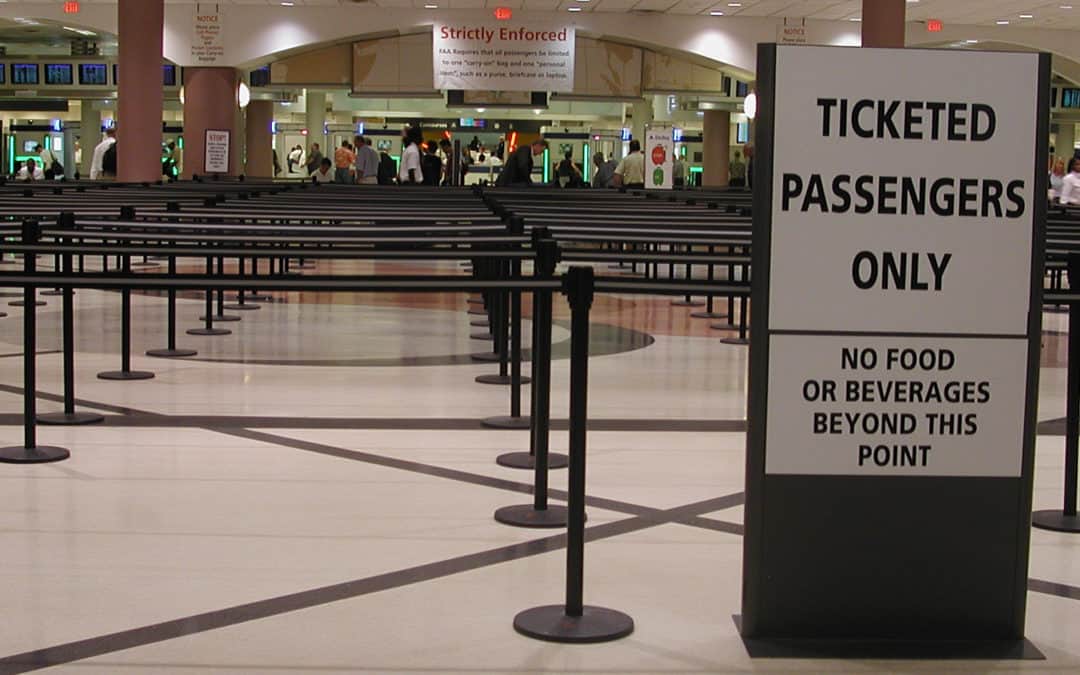Picture this, you’ve arrived at the airport ready for a quick security check. After a smooth check-in, you’re planning to shop and get a bite to eat while you wait for your flight. Couldn’t picture it?
Unfortunately, waiting in line at an airport is unavoidable. Lines mean time. You know the general rule; arrive at the airport at least two hours before boarding the plane. Over the past years, the airport environment has increased in passengers, flights and safety precautions, but have few expansions. This leads to queue management issues like frustrated people waiting in line, risking missing their flights. The success of an airport relies heavily on passenger experience, which is why a structured and optimal queuing system is paramount.
One solution that many airports turn to for queue management is Tensabarrier stanchions.
The versatility of these stanchions and the many options provide multiple benefits to several key areas:
Passenger Experience
- Reduced wait time: A structured queue should be attractive and organized leaving a positive impression. This should also maximize the use of space and reduce the perceived wait time.
- Keep passengers informed: Most queue-based frustration is caused by a lack of information. Passengers are likely to have a better experience if they have realistic expectations. Signage will benefit both the passengers and the airport as it can relay protocol and procedures beforehand. Signage ensures the passengers will be properly prepared, making the boarding process easier to understand and lessening wait time.
- Happy employees perform better: With increasing consumer expectations the pressure multiplies for management and staff to ensure a smooth operation. An efficient queue management system alleviates the workload of staff by creating a tidy, structured traffic flow requiring minimal supervision. It also lessens the possibility of employees having to direct traffic or address unhappy guests or passengers. This allows resources to be allocated to other places that directly impact passenger experiences. A satisfied passenger leads to a repeat passenger.
Airport Optimization
- Maximize the time passengers spend purchasing: While an effective queue system obviously optimizes the limited space at an airport it can also inflate revenue. Many passengers look forward to the buying experience before their flights, when the queue lines are too slow oftentimes they no longer have adequate time. An efficient queueing system will maximize the time passengers spend purchasing; ultimately increasing the revenue for the retailers and the airport.
- Faster service equates to better passenger flow: Using a product like the Tensabarrier Stanchion ensures durability required for the high volume encountered daily and the stability needed to prevent the post from easily toppling over. The stanchion also has a retractable belt which will allow an airport to re-design the queue layout when needed. Better passenger flow ensures that every airport’s nightmare of a bottleneck doesn’t happen.
Safety
- Passenger safety is the first priority: Safety is key at any airport which means the most important area requiring a quality queueing system is the TSA checkpoints. Unfortunately, the TSA checkpoints are usually the most tedious queues for the majority of passengers. It is especially important to maximize the use of stanchions and signage throughout this process. No passenger gets on a flight without thinking about their safety these days. An organized queue is crucial to the success of day-to-day operations and eases the mind of every passenger.
The fact is…
Airports are complex, but that doesn’t mean passengers should have negative experiences. In this social age, an excellent passenger experience is pivotal to the growth of any airport. A well-designed queue system proves to minimize frustrating wait times. This allows passengers the time to visit the more enjoyable side of airports- the dining and shopping! Our products will not only help reduce queues but they will help maximize operations.
How effective is queue management at your airport?





